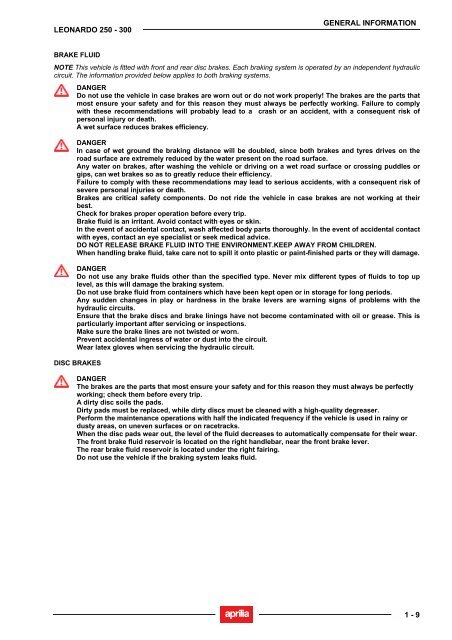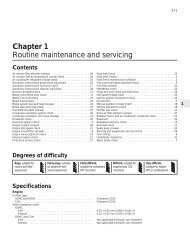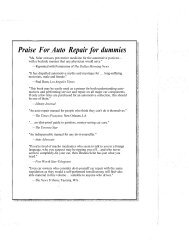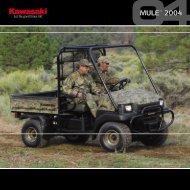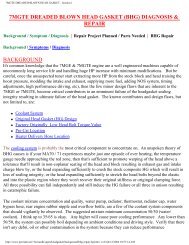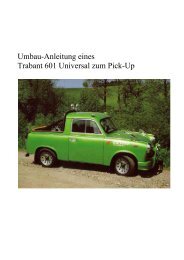Leonardo 250-300 Repair Manual 2004 - Wheels Academy
Leonardo 250-300 Repair Manual 2004 - Wheels Academy
Leonardo 250-300 Repair Manual 2004 - Wheels Academy
Create successful ePaper yourself
Turn your PDF publications into a flip-book with our unique Google optimized e-Paper software.
LEONARDO <strong>250</strong> - <strong>300</strong><br />
GENERAL INFORMATION<br />
BRAKE FLUID<br />
NOTE This vehicle is fitted with front and rear disc brakes. Each braking system is operated by an independent hydraulic<br />
circuit. The information provided below applies to both braking systems.<br />
DANGER<br />
Do not use the vehicle in case brakes are worn out or do not work properly! The brakes are the parts that<br />
most ensure your safety and for this reason they must always be perfectly working. Failure to comply<br />
with these recommendations will probably lead to a crash or an accident, with a consequent risk of<br />
personal injury or death.<br />
A wet surface reduces brakes efficiency.<br />
DANGER<br />
In case of wet ground the braking distance will be doubled, since both brakes and tyres drives on the<br />
road surface are extremely reduced by the water present on the road surface.<br />
Any water on brakes, after washing the vehicle or driving on a wet road surface or crossing puddles or<br />
gips, can wet brakes so as to greatly reduce their efficiency.<br />
Failure to comply with these recommendations may lead to serious accidents, with a consequent risk of<br />
severe personal injuries or death.<br />
Brakes are critical safety components. Do not ride the vehicle in case brakes are not working at their<br />
best.<br />
Check for brakes proper operation before every trip.<br />
Brake fluid is an irritant. Avoid contact with eyes or skin.<br />
In the event of accidental contact, wash affected body parts thoroughly. In the event of accidental contact<br />
with eyes, contact an eye specialist or seek medical advice.<br />
DO NOT RELEASE BRAKE FLUID INTO THE ENVIRONMENT.KEEP AWAY FROM CHILDREN.<br />
When handling brake fluid, take care not to spill it onto plastic or paint-finished parts or they will damage.<br />
DANGER<br />
Do not use any brake fluids other than the specified type. Never mix different types of fluids to top up<br />
level, as this will damage the braking system.<br />
Do not use brake fluid from containers which have been kept open or in storage for long periods.<br />
Any sudden changes in play or hardness in the brake levers are warning signs of problems with the<br />
hydraulic circuits.<br />
Ensure that the brake discs and brake linings have not become contaminated with oil or grease. This is<br />
particularly important after servicing or inspections.<br />
Make sure the brake lines are not twisted or worn.<br />
Prevent accidental ingress of water or dust into the circuit.<br />
Wear latex gloves when servicing the hydraulic circuit.<br />
DISC BRAKES<br />
DANGER<br />
The brakes are the parts that most ensure your safety and for this reason they must always be perfectly<br />
working; check them before every trip.<br />
A dirty disc soils the pads.<br />
Dirty pads must be replaced, while dirty discs must be cleaned with a high-quality degreaser.<br />
Perform the maintenance operations with half the indicated frequency if the vehicle is used in rainy or<br />
dusty areas, on uneven surfaces or on racetracks.<br />
When the disc pads wear out, the level of the fluid decreases to automatically compensate for their wear.<br />
The front brake fluid reservoir is located on the right handlebar, near the front brake lever.<br />
The rear brake fluid reservoir is located under the right fairing.<br />
Do not use the vehicle if the braking system leaks fluid.<br />
1 - 9


